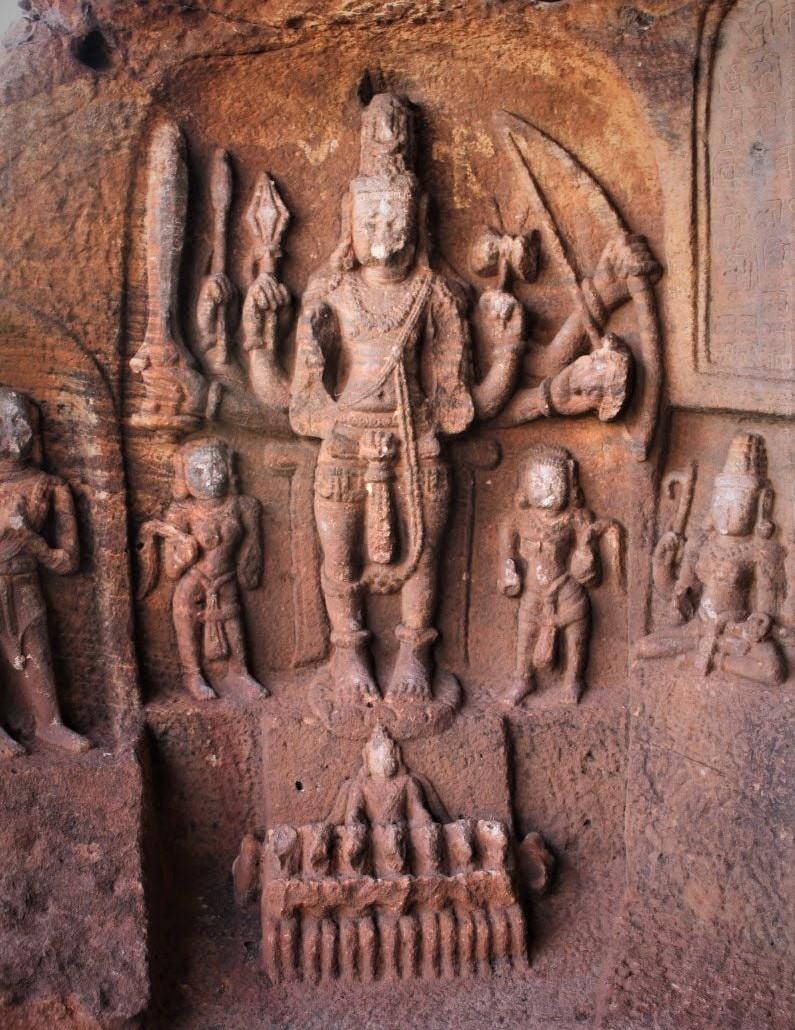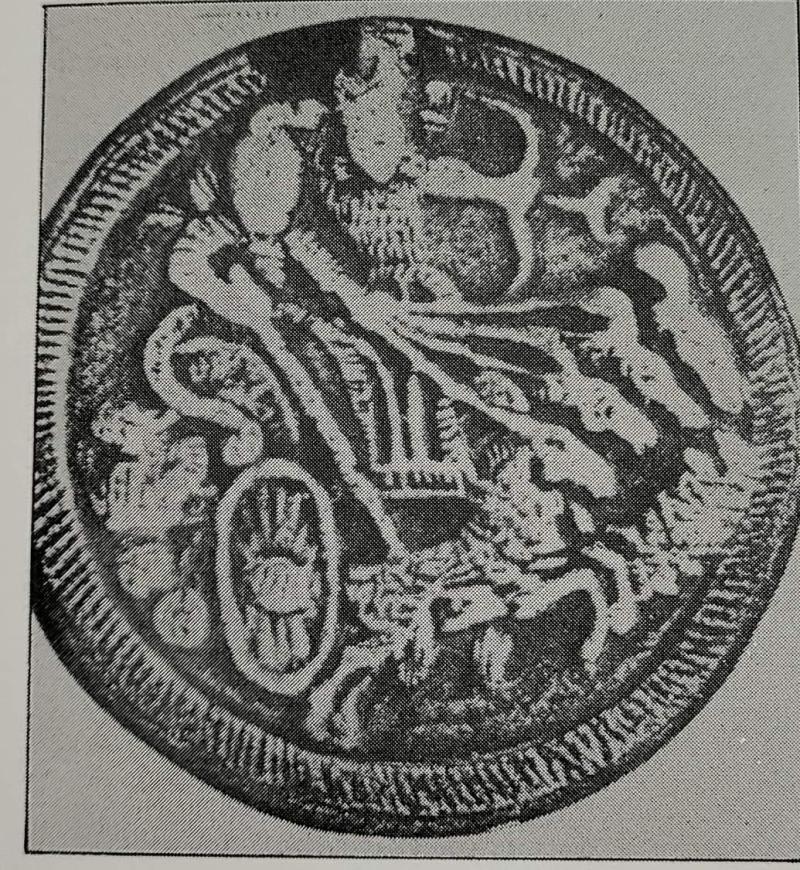Intact images of Surya or the Sun God are found to be very less in the stone relief sculptural art of the Douls built under the patronage of the Ahom dynasty in eastern or Upper Assam from circa 17th to 18th century CE. Exquisite and interesting images of Surya are found in a somewhat intact and identifiable condition only on the architecture of the Jagaddhatri Doul and Vishnu / Siva Doul on the banks of the tank known as Barpatra Pukhuri at Kalugaon in Sivasagar district, eastern Assam. These two images are, in our knowledge, the only extant representations of the Sun God in the whole range of architectural stone relief sculptural art of the Ahoms found in Assam.
Iamage 1(Photo - Siddhanta Medhi)
In the image from the Barpatra Vishnu/ Siva Doul ( see Figure 1 ), the figure of Surya, following the general iconographic convention of the Puranas, Agamas and Silpasastras , is depicted seated on his one-wheeled chariot drawn by seven horses. His body is depicted in profile. The chariot as well as the horses are also shown in profile. Surya is shown as having two hands. Neither of his hands are shown holding lotuses, his characteristic attributes as advocated by the classical Sanskrit silpasastra and Murtiprakaranas . Instead, one of his hands is shown to be raised up and holding an object the form of which is not at all understandable. His other hand may be holding the reins of the horses yoked to his chariot. The seven horses are seen to be arranged in a manner by the artisans keeping in mind the constraints and paucity of the space of the niche or Devako?ta inside which the whole image is placed. There seems to be one more smaller figure near the figure of Surya, but it is damaged. It is not clear whether the figure is a male or a female. If the figure is a male, then he may be identified as Aruna, the charioteer of Surya. As he is positioned directly over the first row of horses and also in the front of the figure of Surya, identifying the figure as Aruna may not be wrong. The figure may also be of either Danda or Pingala described to be the attendants of Surya. It may also be thought of as Revanta/ Remanta/ Rebhanta, a son of Surya as described in the KalikaPurana ( Shastri, 1994, 107 ).
Iamage 2(Photo - Siddhanta Medhi)
The image of Surya from the architecture of the neighbouring Jagaddhatri Doul is in a relatively good condition than the image from the Barpatra Vishnu/Siva Doul. Here too, we can see almost the similar arrangement of the figures as in the previous image. But, here, all the seven horses are seen to be arranged in a single row. All of them are depicted as standing in a uniform pose, with one of their forelegs raised up. A wonderful sense of linear perspective and a three dimensional space is suggested by the arrangement of the horses. Not only in the arrangement of the horses, an expert and meaningful utilization of the very limited space can be seen as made by the artisans in crafting the whole composition ( see Figure 2 ). In this image too, the figure of Surya is two handed. He holds a bow in one of his hands while the other hand holds an arrow. A small figure surely be of his charioteer Aruna holding either a Danda ( staff ) or a whip to control the horses is seen featured just in front of him and just over the row of horses. The most striking feature in this image is the portrayal of a row of four fluttering flags or flag like structures. The symbolism of these four flag like structures cannot be known. It is prescribed in the Agama texts that the chariot or car of Surya should be portrayed as decorated with flags. May be, the flag like structures in the image are depicted following or inspired from such a description.

Iamage 3(Photo - Siddhanta Medhi)
The figure of Surya in the image from the Jagaddhatri Doul is shown holding a bow and an arrow as his attributes which is again a very unique feature. In most of the Sanskrit or Shastric image making texts, Surya is described to hold opened or closed lotus blossoms in his hands as attributes. In the Visvakarma Sastra, Surya as one of the Dvadasa Aditya-s or twelve Aditya or solar deities is described to be four handed and holding lotuses, a Aksamala or rosary and a Kamandalu ( Rao, 1997, 310 ). We have not come across any such description in these texts where Surya is said to hold a bow and arrow. We also do not come across any such sculpted image of Surya dating back prior to the 15th century CE in Assam where he is shown holding a bow and an arrow as his attributes. But, if we come across a terracotta relief sculpture dating back to circa 3rd century CE from Patna where S?rya is shown wielding a bow and arrow and his charioteer Aruna is holding a Danda or a staff as well as the reins of the horses of the chariot ( see Figure 3 ). Also, we get to see a rock sculpted image from Badami in Karnataka dating back to the Chalukya period ( circa 7th or 8th century CE ) which features a syncretic form of Siva and Surya holding a bow and arrow in two of his eight hands ( see Figure 4 ).

Iamage 4(Photo - Siddhanta Medhi)
May be, the bow and arrow as an attribute of Surya in the image from the Jagaddh?tr? Doul too, hints towards a conception of him merging with another deity. In other words, It may also be a syncretic image. Bow and arrow is generally associated with Rama and Kartikeya. There is an association of Rama with Surya which can be explained through the narrative of Rama invoking the power of Suya through the Aditya Hridaya Stotra before going for war with Ravana and for vanquishing Ravana. Kartikeya too, has been explained by Rao ( 1994, 432 ) as associated with or have originated from Surya and the cult of Surya. He refers to narratives in several texts for supporting this explanation like the Markandaya Purana which says of a narrative of how Visvakarman or Visvakarma abstracted a portion of the solar glory and transferred it to Subrahmamya or Kartikeya ( 431 ). Another text, Bhavisyat Purana states that the Dvarapalaka-s or door keepers/ guardians of Kartikeya are Surya under the name of Rajna and Siva under the name of Srausha ( 431 ). Also, Rao ( 432 ) says of a Dhyana Sloka currently prevalent in some parts of southern India which actually describes Kartikeya as Surya.
The bow and arrow as an attribute of S?rya in the image from the Jagaddhatr? Doul may also be depicted by the artisans following some local convention or belief system prevalent in the region, which associates Surya or the solar principle with the motif/ symbol of bow and arrow.
Works Cited-
Rao, T.A.G. (1997). Elements of Hindu Iconography, Vol I, Part II. Motilal Banarsidass Publishers Pvt. Ltd., Delhi.
Shastri, B. (1994). Kalikapurane Martivinirdesah. IGNCA and Motilal Banarsidass Publishers Pvt. Ltd., Delhi.
Siddhant Medhi
Siddhant Medhi is a research scholar in the Department of Culture Department, Tezpur University. The views expressed are the author’s own. He can be reached at [email protected]